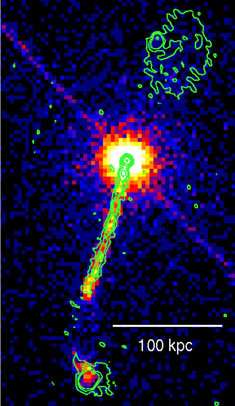The remarkable jet of the quasar 4C+19.44

Quasars are galaxies with massive black holes at their cores. So much energy is being radiated from near the nucleus of a quasar that it is much brighter than the rest of the entire galaxy. Much of that radiation is at radio wavelengths, produced by electrons ejected from the core at speeds very close to that of light, often in narrow, bipolar jets that are hundreds of thousands of light-years long. The fast-moving charged particles can also scatter photons of light, kicking them up in energy into the X-ray range. Even after more than two decades of study, however, there is still no clear conclusion as to the physical mechanism actually responsible for the X-ray emission. In more powerful quasars, it does appear that this scattering process dominates. In lower power jets, however, the emission characteristics suggest that the X-ray emission is dominated by magnetic field effects, not scattering.
The lead author of a new paper on the remarkable jet in the quasar 4C+19.44 is CfA astronomer Dan Harris, who very sadly passed away in December, 2015, after a long and productive career. His CfA teammates on this project, Dan Schwartz with Nicholas Lee and Aneta Siemiginowska, worked to finish the research together with an international team of colleagues. The scientists undertook a detailed, high spatial resolution study of the straight, three hundred thousand light-year long jet in this quasar using multiwavelength data from the Chandra (X-ray), Spitzer (infrared), and Hubble (optical) space observatories as well as from the Very Large Array (radio).
The combination of multiwavelength observations with high spatial resolution enabled the team to measure the characteristics of the emission systematically in ten distinct knots along the jets. They find that both the magnetic field strength and the particle velocities are (remarkably) quite constant all along the length of this jet, at least when presuming the scattering process dominates. But the scientists are not able to exclude magnetic effects as producing some of the X-ray emission. They do conclude, however, that for the magnetic process to be active, any electrons contributing to it must belong to a separate population that is distinct from the electrons that dominate the scattering.
More information: D. E. Harris et al. A Multi-band Study of the Remarkable Jet in Quasar 4C+19.44, The Astrophysical Journal (2017). DOI: 10.3847/1538-4357/aa845c , arxiv.org/abs/1708.01500
Journal information: Astrophysical Journal
Provided by Harvard-Smithsonian Center for Astrophysics




















